Organs in Multi-cellular Organisms
Grade 7 Science Worksheets
What is the order of the levels of organization in a multicellular organism?
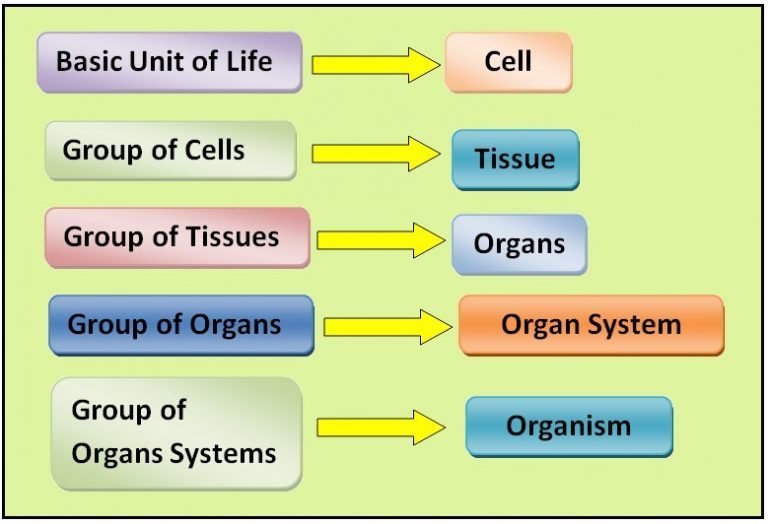
All multi cellular organisms like large animals and human beings have various organ systems that work together, carrying out activities that keep us alive.
The body has various smaller units that build and work together. For any living being to live, eat and develop themselves all organs of the body must function properly for example the digestive, nervous systems, circulatory system.
The timely activity of all the organs helps all the systems to function efficiently. For example, circulatory system circulates blood. If it didn’t transport blood on time. It affects the entire body.
Schedule a Free session to clear worksheet doubts
No credit card required, no obligation to purchase.
Just schedule a FREE Sessions to meet a tutor and get help on any topic you want!
Multi and unicellular beings and their organ systems
Why are there different types of cells in the body of multi-cellular organisms?
Human beings are multi cellular organisms. We have complex bodies and have more than 30 trillion cells; these cells are not in direct contact with the outer environment. These cells are incapable of absorbing nourishment’s directly from the environment.
Unlike single–celled organisms like euglena, amoeba which has a tendency to breed in a place rich in nutrition. It directly and easily absorbs nutrients from the environment. It gets its oxygen to perform body functions that also gets easily absorbed or diffused into its cell through its cell membrane, and also carbon dioxide and other wastes gets out in the same way. For reproduction, it easily just divides itself in two.
A Picture of an amoeba
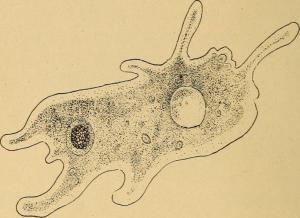
Credit: https://www.flickr.com/photos/internetarchivebookimages/14576590949/
Such easy processes does not happen with the cells present in large multi cellular organisms but they get their nutrition from a source which is an enclosed fluid called extracellular fluid a fluid found just outside of cells. The cells receive oxygen and nutrients from this fluid and release waste products into it.
All organ systems carry out their assigned functions. For example, our respiratory system along with our circulatory system helps to take in oxygen and lets out carbon dioxide; our digestive system digests and processes food. The skeletal system makes our movement possible; the endocrine system secretes hormones; and the excretory system gets rid of food waste.
Organs of the human body
Cardiovascular System
It helps maintain body temperature and pH levels meaning potential of hydrogen, this helps to control acid levels and alkalinity in our body. It also transports oxygen and nutrients, to the cells and removes wastes and CO2 from the same.
Organ tissues that are involved are: heart blood and blood vessels.
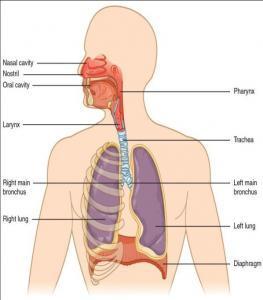
Credit: http://www.humananatomydiagram.com/wp-content/uploads/2017/04/organs-and-structures-of-the-respiratory-system-c2b7-anatomy-and-with-basics-of-anatomy-and-physiology-of-human-body.jpg
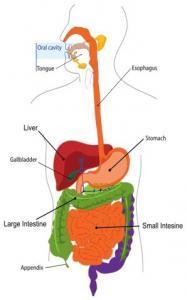
Credit: http://www.earthslab.com/physiology/digestive-system/
Digestive System
Its main function is to digest food and absorb the nutrients, minerals, vitamins, carbohydrates, protein and water from the food taken in.
Organ tissues that aid are: Mouth, salivary gland, food pipe or esophagus, stomach, liver, pancreas, gall bladder, small intestine, large intestine.
Helps to defend against dangerous infection and diseases and transfers lymph between tissues and the blood vessels.
Organ Tissues that aid are: Lymph nodes, and lymph vessels
Endocrine System
Develops a communication process within the body with the help hormones and makes long-term change in other organ systems.
Tissue systems that connect are: Pituitary gland, thyroid, parathyroid, adrenals, testes, and ovaries.
Muscular system
It helps us to move around, support, flexibility and mobility of the body.
Tissues involved: smooth muscles and skeletal muscles.
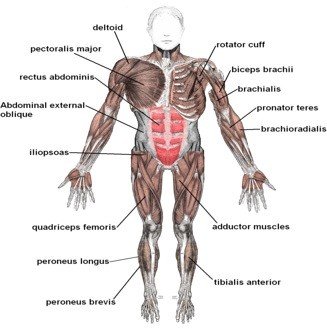
Credit: http://anatomybody101.com/tag/human-body-internal-organs-chart/
Nervous System
The nervous system mainly picks up required data and transfers that for information processing. It then sends and receives the data from the central nervous system (brain).
Organs involved are: brain, sensory nerves, spinal cord.
Reproductive System
Produces gametes and sex cells, embryo to produce offspring or young ones
Organs involved: male body has prostate, and penis. Female body has ovaries, uterus.
Respiratory system
It is a set of organs and tissue systems which help to take in air rich in oxygen and exhaling air rich in carbon dioxide.
Organs involved: Mouth, nose, larynx, pharynx, lungs, bronchi
Skeletal System
It protects soft underlying tissues of the body, provides for flexibility and movement to the joints. It produces cells carrying blood, and stores the nutrients.
Organs involved: Joint muscles, cartilage, tendon, and ligament.
Urinary System
This system removes excess water and salts, natural acids and controls the ph level (potential of hydrogen) of the body.
Organs: Kidneys, urethra, urinary bladder, ureters.
Immune System
The immune system fights against micro pathogens and basically the disease-causing antibodies and other diseases.
Tissue systems which work here are leukocytes, thymus, spleen, tonsils, also other skin tissues.
Learn more about Organs in Multi-Cellular Organisms and other important topics with 7th Grade Science Tutoring at eTutorWorld. Our expert science tutors break down the topics through interactive one-to-one sessions. We also offer the advantage of customized lesson plans, flexible schedules and convenience of learning from home.
Personalized Online Tutoring from eTutorWorld
eTutorWorld offers affordable one-on-one live tutoring over the web for Grades K-12, Test Prep help for Standardized tests like SCAT, CogAT, MAP, SSAT, SAT, ACT, ISEE and AP. You may schedule online tutoring lessons at your personal scheduled times, all with a Money-Back Guarantee. The first one-on-one online tutoring lesson is always FREE, no purchase obligation, no credit card required.
For answers/solutions to any question or to learn concepts, take a FREE TRIAL Session.
No credit card required, no obligation to purchase.
Just schedule a FREE Sessions to meet a tutor and get help on any topic you want!
Check Point
I. Describe the functions of the following:
- Immune system
- Nervous system
- Lymphatic system
- Endocrine system
- Cardiovascular system
Answer Key
I. Describe the functions of the following –
- Immune System: Fights against micro pathogens, disease-causing antibodies and other diseases.
- Nervous System: The nervous system mainly picks up required data and transfers that for information processing. It then sends and receives the data from the central nervous system (brain).
- Lymphatic System: Helps to defend against dangerous infection and diseases and transfers lymph between tissues and the blood vessels.
- Endocrine System: Develops a communication process within the body with the help hormones and makes long-term change in other organ systems.
- Cardiovascular System: It helps maintain body temperature and pH levels that is acid levels in our body. This means potential of hydrogen. It also transports oxygen and nutrients, to the cells and removes wastes and CO2 from the same.
Learn more about Scientific Method and other important topics with 7th Grade Science Tutoring at eTutorWorld. Our expert science tutors break down the topics through interactive one-to-one sessions. We also offer the advantage of customized lesson plans, flexible schedules and convenience of learning from home.
Pricing for Online Tutoring
| Tutoring Package | Validity | Grade (1-12), College |
|---|---|---|
| 5 sessions | 1 Month | $124 |
| 1 session | 1 Month | $25 |
| 10 sessions | 3 months | $239 |
| 15 sessions | 3 months | $354 |
| 20 sessions | 4 months | $449 |
| 50 sessions | 6 months | $1049 |
| 100 sessions | 12 months | $2049 |
6th Grade Free Worksheets
- Elements & Compounds
- Solar Energy
- Photosynthesis
- Digestive System
- Electricity and Magnetism
- Law of conservation of energy
- Law of Conservation of Mass
- Periodic table
- Properties of Matter
- Waves
- Energy Resources
- Weather and Climate
- Immune, Circulatory and Digestive Systems
- Organs in Multi-cellular Organisms
- Sedimentary, Igneous, and Metamorphic Rocks
- Structure of the Earth
- Physical and Chemical Changes
- Scientific Method
- Cycles in Nature
- Environmental Science
- Renewable and Non-renewable energy Resources
- Characteristics of Living Organisms
- Life Science
- Earth and Space Science
- Solar Eclipse
- Heat Technology
- Newton’s Laws of Motions
- Physical Science
- Tools, Measurement and SI Units
- Earth Atmosphere
- Interactions of Living things
- The Earth Ecosystem
- Organelles in Plant and Animal cells
- Layers of the Earth


